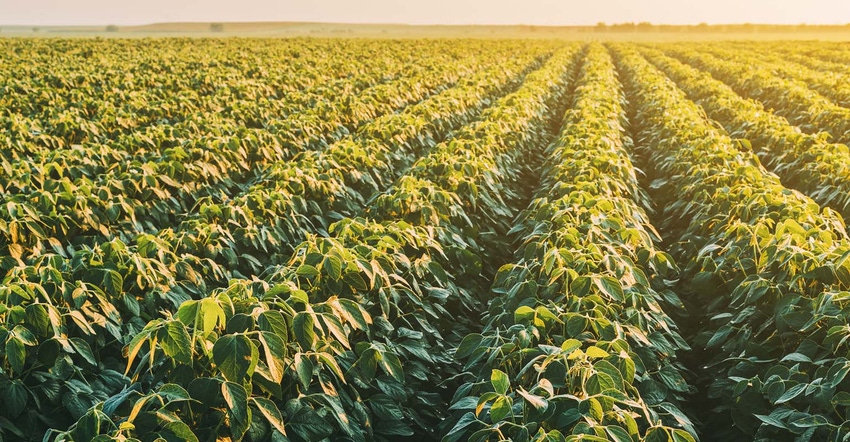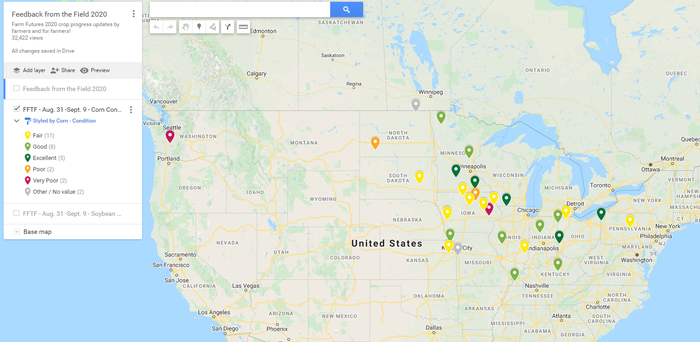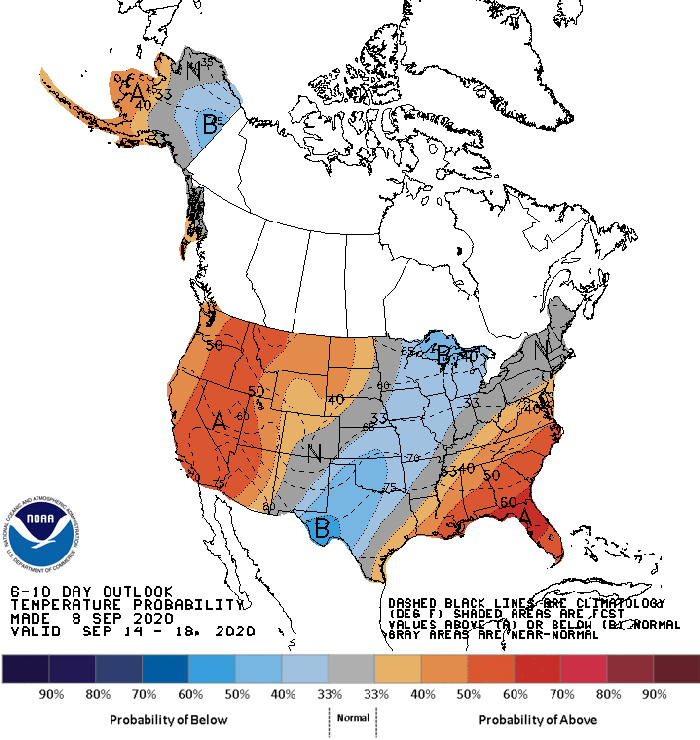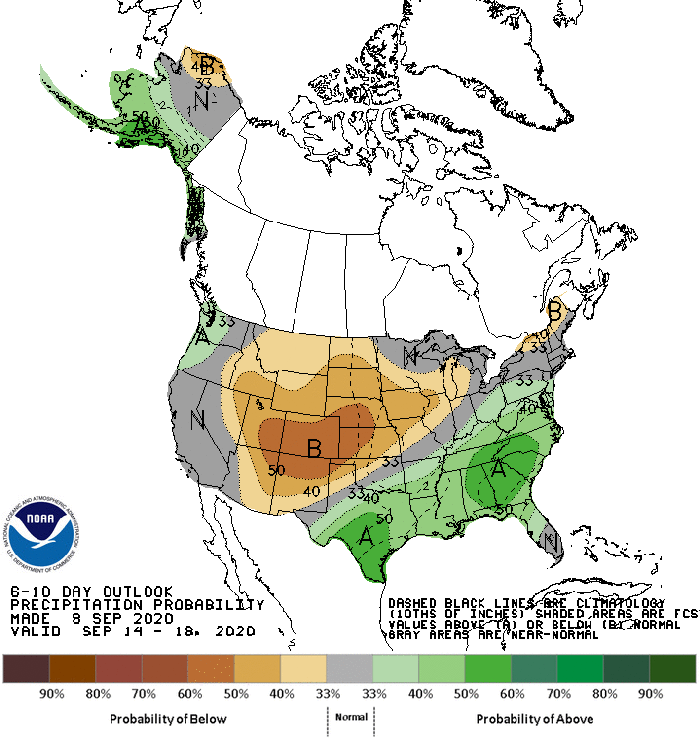
Soybeans finally succumbed to the heat as reports of pods aborting plagued social media and farm websites last week even amid cooler temperatures and scattered showers. Soybean ratings dropped 1% on the week to 65% good to excellent for the week ending September 6.
Cooling temperatures in the Northern U.S. could impact soybean conditions there. A North Dakota farmer reported, “26.9 degrees overnight. All but the earliest varieties are shot.”
Weed pressure in Ohio last week provided a preview of what may come next year after Dicamba was taken off the market earlier this summer. One Ohio Farm Futures reader stated “heavy weed pressure from giant ragweed this year. We were not able to spray Dicamba.”
But several reports throughout the year of crop damages due to chemical drift were persistent from Feedback from the Field respondents. “Crop damaged by dicamba over drift not only locally but many miles around,” a Minnesota grower lamented.
Soybean ratings in Illinois, the largest soybean producer in the country, fell 4% to 51% good to excellent. Ratings in wind-torn Iowa were a mere 47% good to excellent, the lowest of the top 15 soybean-producing states in the U.S. Iowa is second only to Illinois in terms of annual soybean production volume. Heat stress and wind damage could take a significant toll on production forecasts due out by USDA on Friday.
Similar to corn, soybean crop maturation sped up amid warm and dry temperatures late last week. With virtually all U.S. soybeans setting pods as of last week, focus shifted to the number of soybeans dropping leaves as the crop matures. About 20% of the nation’s soybean plants had dropped leaves as of Sunday, up 12% from the previous week and 4% ahead of the five-year average.
“We never got the August rain. It’s raining now but may be too late. We will know in a couple weeks,” wrote an Iowa farmer. “[It’s] just like corn,” a Kansas farmer pointed out. “We were looking at phenomenal yields now we’re looking for very good yields.”
Cooler temperatures this week should help to slow rapid maturation paces. But the heat stress of August sent many farmers scrambling to prepare for an early harvest as fast crop maturation continues to push up harvest windows for many growers in the Midwest.
Corn continues to slide
Corn ratings continued lower in yesterday’s latest Crop Progress report. As expected by the trade, ratings fell 1% to 61% good to excellent for the week ending August 6, 2020. Cooler temperatures and some rain from Hurricane Laura early last week prevented a larger slide, though a heat wave over the Plains this weekend deteriorated conditions in Nebraska (-2%), Iowa (-2%), Kansas (-3%), and South Dakota (-6%).
A Minnesota grower reported signs of frost with the cold front currently moving through the Heartland. “Frost on mornings of 9-8 and 9-9,” the farmer said. “We will see in the next few days how bad the damage will be.”
For the week 35 reporting week that ended September 6, Iowa’s good to excellent ratings on its corn crop stood at 43%. There have only been six years in the prior 34 when ratings for the same reporting week were lower than 43% good to excellent for the nation’s top producer of corn.

“Corn is firing for lack of moisture,” one Eastern Iowa Feedback from the Field respondent wrote. “We will see in the next few days how bad the damage was.” Another farmer in Northeastern Iowa lamented the dry conditions, noting there was, “some wind damage in early July. We needed rain 3 weeks sooner.”
With virtually all of the nation’s corn crop completing the dough stage (97%) as of last week, more attention shifted to how quickly harvest may be approaching. Last week’s weather brought 79% of U.S. corn to the denting stage, up a rapid 16% from the previous week and 8% ahead of the five-year average. Maturation rates sped up considerably last week as well, rising 13% from the week prior to 25% mature as of September 6.
“Heat at the end of August took off top end yield,” a South Dakota reader observed. Another Minnesota farmer was growing concerned about fast maturity paces, observing the corn crop is “maturing at least 3 weeks earlier than last year.”
Crop ratings in Minnesota and Wisconsin remain strong, with ratings in states bordering the Great Lakes averaging a 65% good to excellent rating even amid dry soil moisture levels. Will strong yields from marginal acres overpower poor conditions in the nation’s best soils? Friday’s WASDE report will likely provide fresh insights to crop damage over the past few weeks.
Spring wheat races Mother Nature
Soft white wheat harvest in the U.S. was about 82% complete as of last Friday. Favorable weather conditions are allowing harvest paces to inch towards a close for both winter and spring crops in the Pacific Northwest. The winter crop likely only has a week or two left of harvest while the spring wheat crop has move well past the halfway point in Idaho (72%), Oregon (79%), and Washington (62%). Test weights remain high while protein contents are testing low, both factors that are favorable for soft white wheat.
A little farther east, hard red spring wheat harvests in the Northern Plains approached 69% completion late last week. North Dakota (59%), Montana (74%), and Minnesota (85%) continued to take advantage dry weather and warm temperatures last week, which should help increase progress paces in today’s Crop Progress report. But as cool evening temperatures settle in and daylight time narrows, harvest progress could begin to slow this week.
But early yield reports may not be as favorable as originally expected. “Crop is coming in below average,” a North Dakota spring wheat producer said. “Disappointing yields and quality,” echoed a Minnesota grower.
Durum harvests in the far north will face similar weather headwinds this week. At nearly 50% complete as of Friday, harvest paces in Montana (46%) and North Dakota (53%) will need warm and dry days to keep progressing to the finish line.
Spring wheat harvest continued along in the Northern U.S. last week. As of September 6, 82% of spring wheat had been harvested, up 13% from the previous week due in large part to warm and dry weather. Harvest pace inched a little closer to the five-year average of 87% for the same reporting week, narrowing the difference by 3% from last week.
But harvest paces could slow this week as cooler nighttime temperatures and less daylight shrink the daily harvest window. The spring wheat season got off to a late start on cool and wet weather this spring, so clear skies forecasted in the Pacific Northwest and Northern Plains this week could help farmers continue to combine at a rapid speed to beat fall weather to harvest’s close.
Dry weather could help harvest
NOAA’s 6 to 10 day outlook shows a strong likelihood for lower temperatures across the Plains and Upper Great Lakes regions to continue early next week. Temperatures will likely warm to a near-normal level across most growing areas in the Corn Belt by late next week, favoring early harvest conditions where possible.

Rainfall after this week will likely continue to be scarce as the probability of below normal rainfall levels rises between 33% - 50% across the Plains and Upper Midwest. The far Eastern Corn Belt could see a higher chance of showers next week but overall, the dry weather that damaged yield potential in August could help advance harvest progress in top corn and soybean producing areas going forward.

Follow along with the season:
Feedback from the Field Roundup - Week ending August 30 - Corn, soybean ratings continue to slide lower.
Feedback from the Field Roundup – Week ending Aug. 23, 2020 - A closer look at derecho crop damage sends corn ratings tumbling.
Feedback from the Field Roundup: Week Ending August 9, 2020 - Dry conditions expected to be exacerbated by yesterday’s derecho winds.
Feedback from the Field Roundup: Week ending August 2, 2020 - Wheat harvest rolls on in the Northern U.S.
Feedback from the Field Roundup – Week ending July 26, 2020 - Improved corn conditions offset drought, wind damage.
Feedback from the Field – Week ending July 19, 2020 - Crops withstand the heat while pastures and rangeland suffer lowest ratings since 2012.
Feedback from the Field: July 7, 2020 - Crops stand up to hot weather – for now.
Feedback from the Field: June 30, 2020 - Despite strong ratings, the corn crop may face challenges during silking process.
Feedback From The Field: June 23, 2020 - Readers report solid corn and soybean crop quality so far this year.
About the Author(s)
You May Also Like






